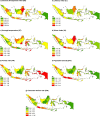Spatial differentiation and determinants of COVID-19 in Indonesia
- PMID: 35606710
- PMCID: PMC9125018
- DOI: 10.1186/s12889-022-13316-4
Spatial differentiation and determinants of COVID-19 in Indonesia
Abstract
Background: The spread of the coronavirus disease 2019 (COVID-19) has increasingly agonized daily lives worldwide. As an archipelagic country, Indonesia has various physical and social environments, which implies that each region has a different response to the pandemic. This study aims to analyze the spatial differentiation of COVID-19 in Indonesia and its interactions with socioenvironmental factors.
Methods: The socioenvironmental factors include seven variables, namely, the internet development index, literacy index, average temperature, urban index, poverty rate, population density (PD) and commuter worker (CW) rate. The multiple linear regression (MLR) and geographically weighted regression (GWR) models are used to analyze the impact of the socioenvironmental factors on COVID-19 cases. COVID-19 data is obtained from the Indonesian Ministry of Health until November 30th 2020.
Results: Results show that the COVID-19 cases in Indonesia are concentrated in Java, which is a densely populated area with high urbanization and industrialization. The other provinces with numerous confirmed COVID-19 cases include South Sulawesi, Bali, and North Sumatra. This study shows that the socioenvironmental factors, simultaneously, influence the increasing of confirmed COVID-19 cases in the 34 provinces of Indonesia. Spatial interactions between the variables in the GWR model are relatively better than those between the variables in the MLR model. The highest spatial tendency is observed outside Java, such as in East Nusa Tenggara, West Nusa Tenggara, and Bali.
Conclusion: Priority for mitigation and outbreak management should be high in areas with high PD, urbanized spaces, and CW.
Keywords: COVID-19; Socioenvironmental factors; Spatial interaction.
© 2022. The Author(s).
Conflict of interest statement
The authors declared that they have no competing interests.
Figures








Similar articles
-
Spatial analysis of stunting determinants in 514 Indonesian districts/cities: Implications for intervention and setting of priority.Geospat Health. 2022 May 17;17(1). doi: 10.4081/gh.2022.1055. Geospat Health. 2022. PMID: 35579253
-
Challenges for control of taeniasis/cysticercosis in Indonesia.Parasitol Int. 2006;55 Suppl:S161-5. doi: 10.1016/j.parint.2005.11.025. Epub 2005 Dec 27. Parasitol Int. 2006. PMID: 16380290 Review.
-
A study of African swine fever virus in Regional VI of the Disease Investigation Center of Denpasar Bali in Indonesia.Vet World. 2023 Apr;16(4):844-850. doi: 10.14202/vetworld.2023.844-850. Epub 2023 Apr 21. Vet World. 2023. PMID: 37235158 Free PMC article.
-
Blindness and Visual Impairment Situation in Indonesia Based on Rapid Assessment of Avoidable Blindness Surveys in 15 Provinces.Ophthalmic Epidemiol. 2021 Oct;28(5):408-419. doi: 10.1080/09286586.2020.1853178. Epub 2020 Dec 30. Ophthalmic Epidemiol. 2021. PMID: 33380229
-
Japanese encephalitis in Indonesia: An update on epidemiology and transmission ecology.Acta Trop. 2018 Nov;187:240-247. doi: 10.1016/j.actatropica.2018.08.017. Epub 2018 Aug 15. Acta Trop. 2018. PMID: 30118700 Review.
Cited by
-
The impact of urban spatial environment on COVID-19: a case study in Beijing.Front Public Health. 2024 Jan 8;11:1287999. doi: 10.3389/fpubh.2023.1287999. eCollection 2023. Front Public Health. 2024. PMID: 38259769 Free PMC article.
-
COVID-19 vaccination and governance in the case of low, middle and high-income countries.BMC Public Health. 2023 Jun 5;23(1):1073. doi: 10.1186/s12889-023-15975-3. BMC Public Health. 2023. PMID: 37277743 Free PMC article.
-
The major risk factor of stroke across Indonesia; a nationwide geospatial analysis of universal health coverage program.Arch Public Health. 2025 Jul 1;83(1):169. doi: 10.1186/s13690-025-01613-4. Arch Public Health. 2025. PMID: 40598345 Free PMC article.
-
From Archipelago to Pandemic Battleground: Unveiling Indonesia's COVID-19 Crisis.J Epidemiol Glob Health. 2023 Dec;13(4):591-603. doi: 10.1007/s44197-023-00148-7. Epub 2023 Sep 14. J Epidemiol Glob Health. 2023. PMID: 37707715 Free PMC article. Review.
References
-
- Susilo A, Rumende C, Pitoyo C, Santoso W, Yulianti M, Herikurniawan H, et al. Coronavirus Disease 2019: Tinjauan Literatur Terkini. Jurnal Penyakit Dalam Indonesia. 2020;7:45. doi: 10.7454/jpdi.v7i1.415. - DOI
-
- Rodriguez-Morales AJ, Cardona-Ospina JA, Gutiérrez-Ocampo E, Villamizar-Peña R, Holguin-Rivera Y, Escalera-Antezana JP, et al. Clinical, laboratory and imaging features of COVID-19: a systematic review and meta-analysis. Travel Med Infect Dis. 2020;34:101623. doi: 10.1016/j.tmaid.2020.101623. - DOI - PMC - PubMed
-
- Fajar JK, Ilmawan M, Mamada S, Mutiawati E, Husnah M, Yusuf H, et al. Global prevalence of persistent neuromuscular symptoms and the possible pathomechanisms in COVID-19 recovered individuals: a systematic review and meta-analysis. Narra J. 2021;1(3) Available from: https://narraj.org/main/article/view/48. Cited 30 Jan 2022. - PMC - PubMed
-
- Fahriani M, Ilmawan M, Fajar JK, Maliga HA, Frediansyah A, Masyeni S, et al. Persistence of long COVID symptoms in COVID-19 survivors worldwide and its potential pathogenesis - a systematic review and meta-analysis. Narra J. 2021;1(2) Available from: https://narraj.org/main/article/view/36. Cited 30 Jan 2022. - PMC - PubMed
MeSH terms
LinkOut - more resources
Full Text Sources
Medical
Research Materials

